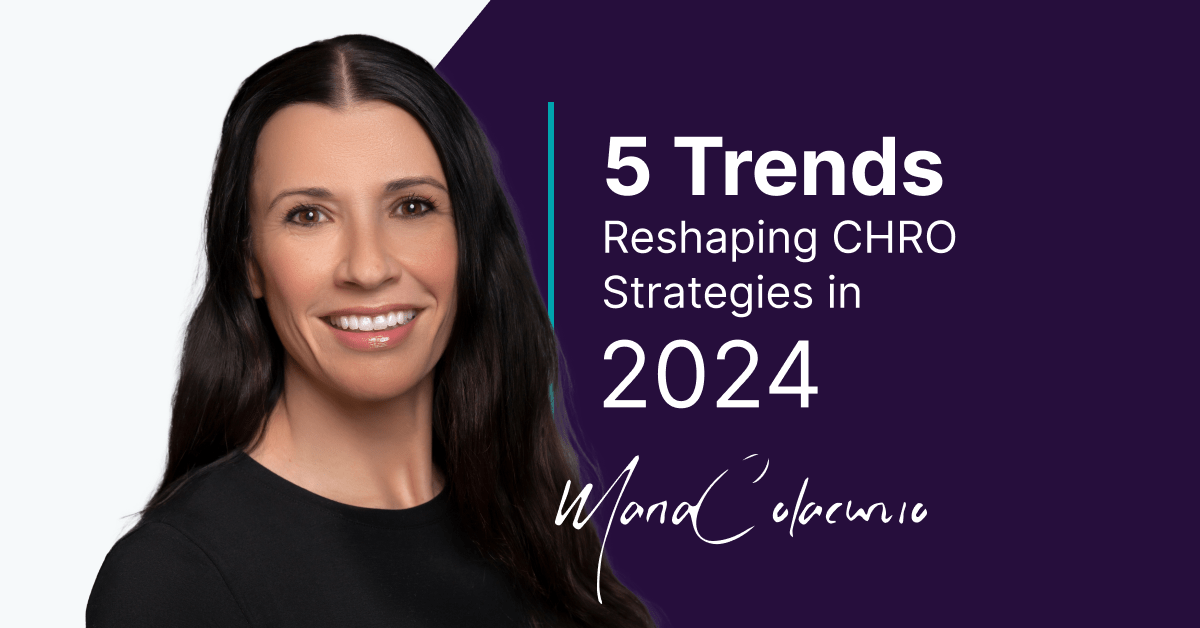The CHRO continues to be in the spotlight, taking on expanding priorities and serving as “growth executives” who connect people, data, and technology to drive long-term profitable growth. What does that big-picture view actually mean for how you lead your organization on a daily basis?
To help you stay a step ahead, here are five trends that will redefine HR in 2024.
1. The CHRO term of the year: “unadjusted pay gap”
If this sounds like something that’s too in the weeds and okay to ignore, think again. The unadjusted pay gap — the difference in mean or median earnings between two populations of employees who perform similar jobs, without statistically accounting for factors such as tenure or years of experience — is quickly becoming the metric to measure whether a company is fair and equitable. And it’s not just a “nice to have” or something to delegate to the legal team. There’s major legislative and shareholder momentum at play (with more coming), and companies are about to get blindsided if they don’t start acting now.
In the U.S., California now requires employers to report unadjusted pay gaps, while the EU Directive on Equal Pay and Transparency is normalizing pay gap reporting (and triggering action to close those gaps) for any multinational.
Closing pay gaps is not a quick fix. Even if you achieve “100% pay parity” — equal pay for equal work between genders, for example — you may still have an all-up, unadjusted pay gap between what female employees earn overall and what male employees earn overall. This can be due to women not being represented in leadership positions and other higher-paying roles over time.
It takes time (years), a solid plan, and incremental changes to close gaps, and organizations will look to CHROs to lead the effort — because the only way to move the needle on the unadjusted pay gap is to create more equitable career progression and mobility.
2. Performance reviews will make or break career equity.
While the headlines tell us that performance reviews are dead, that’s not the case. New survey data show that the majority of enterprise organizations (73%) still rely on annual performance reviews — even though the process is broken by bias.
One in four survey respondents said their performance reviews were negatively affected by their supervisor’s biases. This can contribute to a ‘broken rung,’ which perpetuates opportunity gaps and, in turn, unadjusted pay gaps.
CHROs who try to fix the issue with anti-bias training alone will struggle to make lasting progress. Those who take a new approach in 2024 — one that pairs training with performance review data analytics — will better understand what’s driving or limiting employee career progression and will build more diverse, higher-performing companies.
3. Pay explainability will set companies apart.
Those who think that pay transparency means posting salary ranges are way behind. It’s not enough to simply disclose pay. Now you’ll be responsible for explaining pay both internally and externally, across multiple dimensions of compensation and career opportunity. Why do you reward and promote employees in the ways you do? Why does your company compensate men more than women, or white employees more than employees of color?
Pay explainability is evolving very quickly, especially as disclosures become compulsory and new rankings shine a light on how well companies foster career mobility. Companies that are able to clearly explain compensation and career progression will take control of their workplace equity narrative before being forced to disclose it. They will also build trust with candidates and employees who seek to understand viable career paths.
4. Pay insights will move to the front lines.
As pay transparency and explainability reach a fever pitch, not only compensation and HR pros will have insights on pay. Everyone from front-line managers to recruiters will gain awareness
and engage in pay decisions. CHROs and their teams spend inordinate amounts of time creating pay policies and remediating pay inequities, and you need employees on the front lines following through in ways that are consistent and fair — so you can keep the pay equity progress going.
The assumption that it’s impossible to scale compensation insights, especially at a time when managers are already overwhelmed, is outdated. Advanced data analytics will help CHROs scale insights to every people manager and every decision about rewards.
5. AI will be a competitive advantage (but not for everything everywhere, and not all at once).
There’s no question that AI and generative AI can — and will — deliver value to HR. But it’s important to not let 2023’s fear-mongering and ‘FOMO’ around AI rush your use of AI in 2024. Otherwise, you may be creating more chaos than value.
As CHROs start shifting from experimental use of AI to a more strategic and integrated approach, those who are most discerning about where to leverage AI in HR will be more successful. HR organizations should focus on tapping into their data — if you aren’t already using well-established statistical models to do things like identify bias and make pay recommendations, start there.
Plus, as transparency and explainability extend to AI, CHROs will be the ones leading the conversation to ensure every decision made is traceable back to policies, data, and well-reasoned strategy. AI can provide a lot of value in recognizing patterns, automating processes, and creating and understanding content, but when it comes to making decisions about HR, humans must remain “in the loop” to accept or reject recommendations and justify decisions, whether to employees or regulators or any stakeholders.
The expansion of workplace equity
It’s no longer possible to talk about pay equity without career equity — they’re “inextricably linked.” And talk about it, you will. Increased disclosures and mounting pressure from investors, boards, and employees ups the ante on how you communicate about workplace equity.
As a CHRO, getting ahead of these trends will help you lead employees through this next wave of change, elevate your dialogue with the board, and drive business growth.
For more insights and resources, follow me on LinkedIn and subscribe to Syndio’s content.
The information provided herein does not, and is not intended to, constitute legal advice. All information, content, and materials are provided for general informational purposes only. The links to third-party or government websites are offered for the convenience of the reader; Syndio is not responsible for the contents on linked pages.


